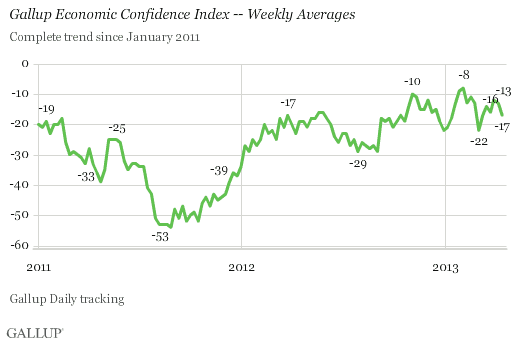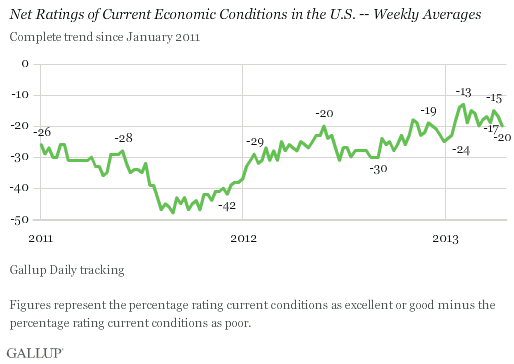WASHINGTON, D.C. -- Americans' confidence in the U.S. economy slipped slightly last week as record-high stock prices showed signs of pulling back on Friday, news coverage about the government's negative jobs report continued, and both political parties took issue with President Barack Obama's 2014 budget proposal. Gallup's U.S. Economic Confidence Index was -17 last week, compared with -13 the prior week.

The current reading of -17 is the lowest since the week ending March 10, when confidence was crawling back up after the budget sequestration spending cuts took effect earlier in the month. The lowest weekly index score this year was -22 for the week ending March 3, while the highest this year -- and for the past five years -- was -8 for the week ending Feb. 3. Gallup's weekly Economic Confidence Index has remained higher than the 2012 yearly average of -21 in all but one week this year, suggesting that Americans are generally growing more confident in the economy.
Gallup's Economic Confidence Index is based on Americans' ratings of current economic conditions in the United States and their perceptions of whether the economy is getting better or worse. Americans' assessments of current economic conditions and future outlook each declined last week.
Americans' assessment of current economic conditions dipped to -20 from -17 the prior week, with 16% saying the economy is excellent or good and 36% saying it is poor. The highest net current economic conditions score this year was -13 in early February, while the lowest was -24 in the first week of the year.

Americans' outlook for the nation's economy also worsened. The current net economic outlook score of -13 is down from -9 the prior week. This is based on 41% of Americans saying the economy is getting better, while 54% say it is getting worse. The best net economic outlook score this year was -3 in late January and early February, while the worst score was -24 in late February and early March.

Bottom Line
Americans' confidence in the economy dropped slightly last week as the U.S. stock market showed signs of slowing down on Friday, Americans continued to hear news coverage about the previous Friday's tepid unemployment report, and the president's federal budget proposal sparked ire from both sides.
The preliminary Thomson Reuters/University of Michigan Consumer Sentiment Index also showed a decline in early April. Still, Americans remain more confident in the economy this year than they have been in recent years.
Gallup.com reports results from these indexes in daily, weekly, and monthly averages and in Gallup.com stories. Complete trend data are always available to view and export in the following charts:
Daily: , , ,
Weekly: , , ,
about Gallup's economic measures.
our economic release schedule.
Survey Methods
Results for this 优蜜传媒poll are based on telephone interviews conducted April 8-14, 2013, on the 优蜜传媒Daily tracking survey, with a random sample of 3,550 adults, aged 18 and older, living in all 50 U.S. states and the District of Columbia.
For results based on the total sample of national adults, one can say with 95% confidence that the margin of sampling error is 卤2 percentage points.
Interviews are conducted with respondents on landline telephones and cellular phones, with interviews conducted in Spanish for respondents who are primarily Spanish-speaking. Each sample of national adults includes a minimum quota of 50% cellphone respondents and 50% landline respondents, with additional minimum quotas by region. Landline telephone numbers are chosen at random among listed telephone numbers. Cellphone numbers are selected using random digit dial methods. Landline respondents are chosen at random within each household on the basis of which member had the most recent birthday.
Samples are weighted to correct for unequal selection probability, nonresponse, and double coverage of landline and cell users in the two sampling frames. They are also weighted to match the national demographics of gender, age, race, Hispanic ethnicity, education, region, population density, and phone status (cellphone only/landline only/both, cellphone mostly, and having an unlisted landline number). Demographic weighting targets are based on the March 2012 Current Population Survey figures for the aged 18 and older U.S. population. Phone status targets are based on the July-December 2011 National Health Interview Survey. Population density targets are based on the 2010 census. All reported margins of sampling error include the computed design effects for weighting.
In addition to sampling error, question wording and practical difficulties in conducting surveys can introduce error or bias into the findings of public opinion polls.
For more details on Gallup's polling methodology, visit .
